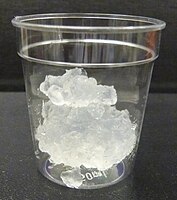
Photo from wikipedia
A novel and bio-based hydrogel nanocomposite were developed using reinforcement of starch grafted copolymers of 2-acrylamido-2methyl propane sulfonate and acrylic acid (starch-g-(AMPS-co-AA)) hydrogel with magnetite-functionalized cellulose nanocrystals (MCNCs). The MCNCs-hydrogel… Click to show full abstract
A novel and bio-based hydrogel nanocomposite were developed using reinforcement of starch grafted copolymers of 2-acrylamido-2methyl propane sulfonate and acrylic acid (starch-g-(AMPS-co-AA)) hydrogel with magnetite-functionalized cellulose nanocrystals (MCNCs). The MCNCs-hydrogel was utilized as a proficient and environmentally benign nanoadsorbent for removal of cationic dyes with great capacity and selectivity. Sugar-beet pulp (SBP) was exploited for CNCs production through acid hydrolysis of enzymatic-mediated SBP. Fe3O4 nanoparticles were anchored on CNCs to synthesize MCNCs as the nanofiller of MCNCs/starch-g-(AMPS-co-AA) hydrogel. The synthesis of CNCs, MCNCs and hydrogel nanocomposite were confirmed using FESEM, FTIR, VSM and TGA analyses. Hydrogel nanocomposite showed excellent and reusable capacity for specific adsorption of cationic dyes. The effects of nanoadsorbent dosage, time, pH, dye initial concentration, and temperature on the adsorption were scrutinized for two model cationic dyes (crystal violet (CV) and methylene blue (MB). Adsorption capacities for CV and MB were 2500.0 mg/g and 1428.6 mg/g, respectively.
Journal Title: Bioresource technology
Year Published: 2020
Link to full text (if available)
Share on Social Media: Sign Up to like & get
recommendations!